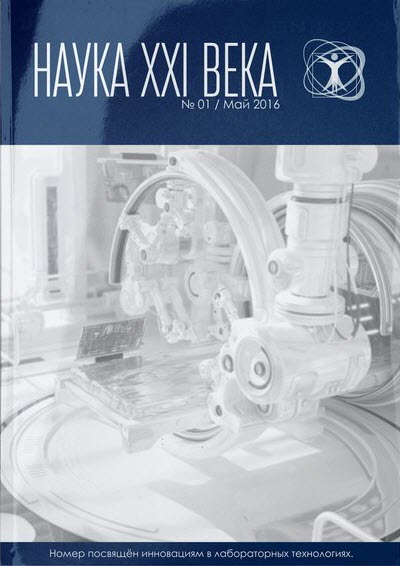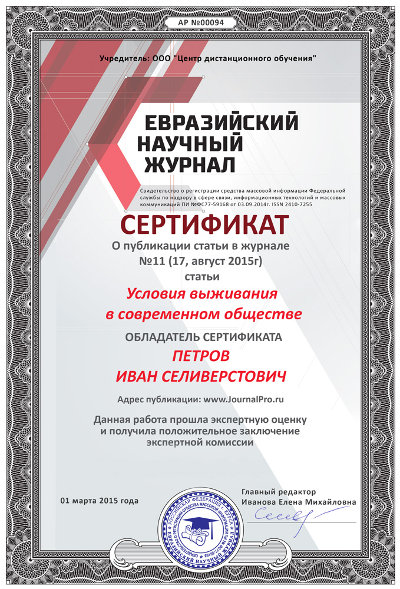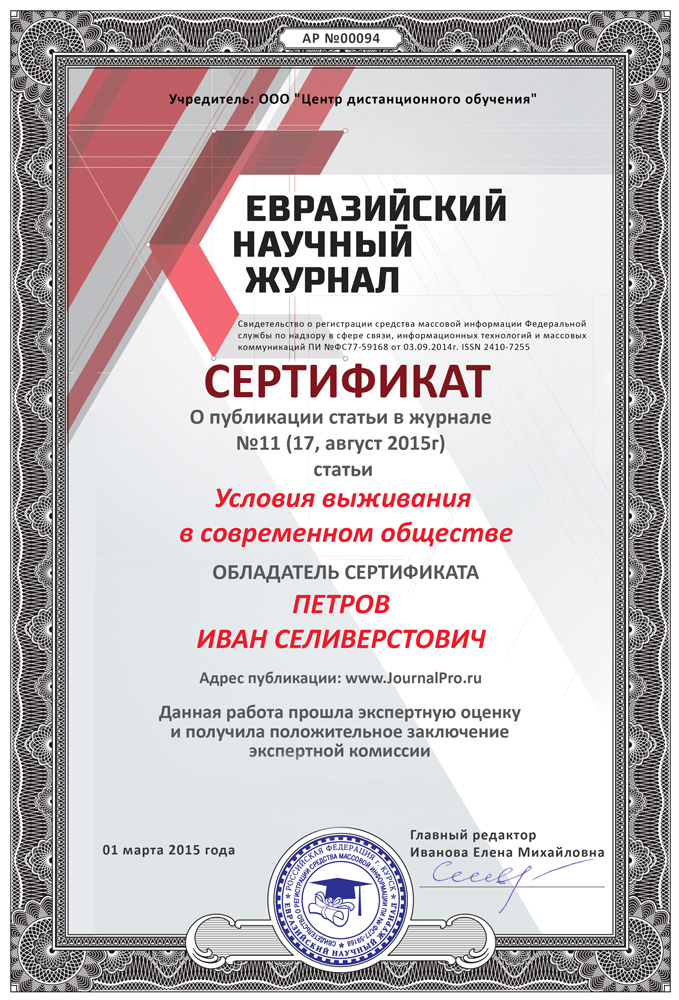Срочная публикация научной статьи
+7 995 770 98 40
+7 995 202 54 42
info@journalpro.ru
Laser beams and their effect on biological skin tissue
Рубрика: Физико-математические науки
Журнал: «Евразийский Научный Журнал №11 2017» (ноябрь, 2017)
Количество просмотров статьи: 2356
Показать PDF версию Laser beams and their effect on biological skin tissue
Luma Jabar Abdalzahra
University of kufa
Faculty of education for women
Department of physics
Summary :
Laser is a distinctive type of optical light with special characteristics that unite the wavelength, direction and similarity.
In our ability to control the length of the wave we can obtain special effects with specific characteristics related to the strength, depth and type of biological impact caused by this beam, as well as can be focused on small points or larger areas according to the requirements of the medical condition. These qualities have made laser one of the most effective types of physical effect in medicine, especially in the treatment of skin lesions. The ease of access and versatility creates a wide range of different types of lasers to obtain effects ranging from removing a thin layer not exceeding ten millimeters of skin or affecting lesions With special color to be removed using a laser frequency and wavelength special absorbed by this colored lesion without any other than the effects of a very small destructive deep in the hair follicle for the removal of unwanted hair.
The laser is not one thing but a set of devices that use different materials (carbon dioxide, argon, rubin, barium, etc.) to obtain specific wave-length laser radiation with the intention of producing one fundamental effect to cure a specific situation. Carbon dioxide that absorbs more than water is not effective for treating colored birthmarks. The deep-impact laser is not suitable for peeling and removing the surface layer of the scarred skin.
Introduction :
Laser emery is used to send short pulses of high-energy light absorbed by water and substances in the skin called carriers. The light is changed to thermal energy and the heat destroys the thin layers of skin one by one. As the wound is healing, a new layer of skin grows to replace the damaged skin that has been removed during laser treatment. Some lasers tighten the skin by heating it without destroying the skin.
Laser CO2 Carbon dioxide is the most common laser emulsifying skin surface. Erbium laser lasers are also often used.
The laser resurfacing laser is extremely delicate and causes slight damage to the surrounding skin and tissues. This is most often done on the face but it can be used on any area of the skin in the body. The hands, neck, and chest can be avoided because the skin in these areas does not heal, as is the case in other areas. Where the skin tends to scarring and becomes thicker due to laser treatment.
Modern laser methods
New methods of laser emery skin cause fewer complications and heal the skin faster, and include these methods:
• Frachennel laser for skin grafting that handles microscopic columns of skin. The treated areas of the skin surround untreated areas leading to marked improvement without further injuries or bleeding.
• Plasma laser for skin peeling, which uses plasma energy to destroy the lower layers of the skin but does not affect the upper layer. This upper layer protects the lower layers of the skin until healing.
* Surface Erbium Laser or Laser YAG which is a kind of gentle laser therapy.
* Infrared laser which targets the deep layers of skin with heat to ensure skin tightening.
How it is done
Areas to be treated are identified. A local anesthetic is usually used to anesthetize the area before treatment. Analgesics or anxiolytics can also be given to help relax. If the whole face is treated, it may be necessary to use a stronger anesthesia (in some cases general anesthesia) or painkillers or venous sedatives. You may need to wear goggles to prevent eye damage by laser.
The laser is passed on the skin, sending impulses. Each pulse lasts less than a millisecond. While the laser is passed the skin is also moistened with water or brine to cool the skin and remove the tissue destroyed by the laser. The number of passes required depends on the size of the area and the type of skin treated. Thin skin around the eyes, for example, requires very few passes with the laser. While the thicker or thickened skin requires more passes.
Laser impulses generate a sensation of biting or burning slightly, or you may feel like a disc in the skin. With little or no bleeding in most cases. When finished, the area is covered with a clean bandage or ointment.
What to expect after surgery
The time required for healing and recovery after laser varies according to the size and depth of the treated area. A person who has a full facial laser surface treatment, for example, will have a longer recovery period than a person who has had a small surface area of skin.
The treated area usually becomes pink, sensitive and swollen for at least several days. Cold compresses and non-steroidal anti-inflammatory drugs (analgesics such as aspirin or ibuprofen) help reduce swelling and pain. Skin redness continues after the skin grows and heals for several weeks.
Proper care for the treated area during the skin healing period is very important
* Rinse the skin several times a day with cold tap water to avoid infection and get rid of crusts that sometimes form. Avoid soap and perfume.
* Change the ointment or bandages on the treated area regularly to keep the area moist and to induce wounds to heal.
*Avoid exposure to sunlight during healing, and use sunscreen every day after peeling stops. The new skin is more vulnerable to sun damage.
The patient will need to follow up with the doctor to monitor skin rejuvenation and re-growth and to identify and treat early signs of inflammation or other complications.
Why this is done
Laser abrasive skin can be used to improve appearance or remove the following:
* Wrinkles
* Surface scars resulting from acne, surgery, or injuries that do not grow or that are getting thicker.
* Color pigments and changes or defects in the skin, such as birthmarks.
Light-skinned people who avoid sun exposure after surgery are the most likely to get the best results. Dark skinned people benefit from surface laser but their skin does not heal easily.
Your doctor may not recommend surface laser treatment if:
* If color changes, scars or fibrosis have occurred in the tissues (increased thickness of the skin) after previous treatment.
* History of abnormal scarring (scar tissue or hypertrophic scars).
* Isotretinoin (a drug used to treat acne) is currently used or used within the past 6 months, because it increases the risk of scars after the operation.
* Bacterial or viral infection in the skin.
How surface laser works well :
Your skin type, condition, level of physician experience, the type of laser used and your lifestyle after the procedure can all affect the short and long term results of surface laser results. Some laser skin problems respond better than others. Light-skinned people who avoid sun exposure after laser treatment have better results than those with dark skin and those who still spend a lot of time in the sun.
In general, surface laser gives good results with relatively low risk.
* Wrinkles caused by aging and long-term sun exposure, such as those around the eyes and mouth, respond well to surface laser. Long-term results for the treatment of these types of laser wrinkles are still unknown, with new wrinkles likely to develop over time as the skin continues to age.
* Wrinkles can be improved by repeated muscle movement (such as those on the front or along the sides of the nose) but can not be eliminated. Wrinkles often reappear after months of treatment because the muscles continue to perform their wrinkling activities before treatment.
* Light or moderate scars can improve for acne to a certain extent. Laser therapy is less effective on severe acne scars. Long-term results of laser therapy may not be obvious for months.
Acne :
Side effects and surface laser risks can include:
* The temporary and expected effects of surface laser in the treated area include swelling, itching, flaking, and a slight pain sensation.
* Redness of the area and usually lasts for several weeks ..
* Tints or color changes in the skin at 30% to 40% of people, especially in dark skin, where the treated area darker than the color of the skin is normal. The skin can be lightened and uniformed by peeling and improves with time gradually. While the skin loses its color in rare cases after treatment with a period of 6 to 12 months and can last this effect especially if laser treatment is deep and intense.
* Skin irritation, including the appearance of acne in people who are prone to acne.
* Bacterial, viral or fungal infections in the skin. Infection may also be transmitted to the rest of the body.
What to think about
Outlook
Surface laser works on the skin wound first and then destroys the upper layers. You should prepare yourself for how your skin will look immediately after treatment and during the healing process. It is also important to follow your doctor’s instructions on skin care after treatment, thus avoiding inflammation and helping to heal quickly.
Be sure that your doctor understands what you want to achieve, and you should be aware of the expected results in real terms. Even with logical predictions you may not see results for several weeks or months after treatment. You may need more than one session of treatment to achieve the results you desire.
Sun protection
After surface laser you should use sunscreen every day and avoid exposure to sunlight as much as possible. Where the new skin is more vulnerable to damage and discoloration by sunlight.
Skin peeling options
Surface laser, chemical peeling, and surgical skin whitening are the most common methods of improving skin texture and appearance. Although these techniques use different methods, they have the same effect on the skin and are based on the same basis is the destruction and removal of the upper layers of the skin to allow the growth of the skin again.
There is not necessarily a better way than the other, when the procedure is done by an experienced surgeon, the surface laser is the most accurate of the chemical peeling or surgical laceration. The choice of method depends on the area to be treated, the type and condition of the skin, the doctor’s experience and what the patient prefers. Some may get better results using more than one technique.
Bibliography
- Levine V,Geronemus R : Tattoo removal with Q-switched ruby laser andthe NdYAG a comparative study , Lasers Surg Med Suppl,1999.
- S.HALL,PH.D:. BASIC BIOMECHANICS Secoud edition printed in the U.S.A USAH.J. 1995.
- Brannon F : Exprumentation in Exercise Physiology, Kendall Hunt Publishing, 1975.
- Goldman Rockwell Lasers Gordon, Breach in medicine, New York , 1971.
- Jun Kimura :Electro diagnosis in diseases, USA,1983.
- BEOHER, J. thibodeau,.G. Injury Assessment 2nded, COLLGE, Publishing ,st. louis, 1989
- Campbell ,E&edi : clinicians , physiology , F the. Edi Blackwell.sientific publication , oxford London .1984.









